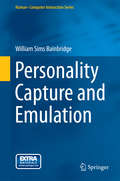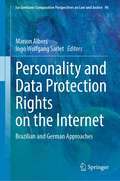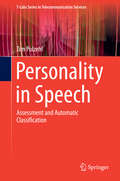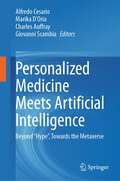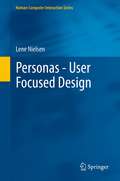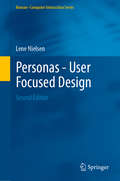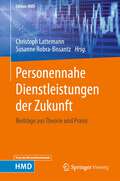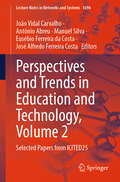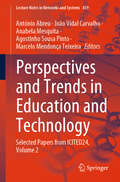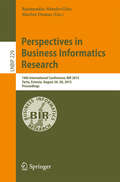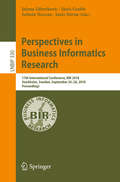- Table View
- List View
Personal Robotics: Real Robots to Construct, Program, and Explore the World
by Richard RaucciMany companies are now offering robots that are geared to the casual electronics hobbyist, both in kit form and as fully assembled models. This book gives an overview of available robot products, ranging from the simple to the complex. Interested readers will be able to find the robot kit that matches their skill level and pocketbook. Beginners may want to try a robot that is already fully assembled, or a kit with pre-assembled electronics. Other readers may opt for kits that require soldering and electronic experience. Other criteria a reader will be able to review include motion systems (robots that roll on wheels, or walk on legs, or robot arms), available sensors (from none to a wide range), and programming complexity (how the robot is programmed). If its not really a robot, its not in this book.
Personalinformationssysteme in der Personalentwicklung und im Talent-Management: Eine empirische Untersuchung zum strategischen Einsatz und zur Rolle von Stakeholder*innen (Personalmanagement und Arbeitsorganisation)
by Jasmin MichlJasmin Michl realisiert eine tiefgehende Untersuchung zum Einsatz von Personalinformationssystemen in der Personalentwicklung und im Talent-Management mit besonderem Fokus auf strategische Einsatzgebiete und die Rolle von Stakeholder*innen. Im Rahmen ihrer Analyse verbindet die Autorin Perspektiven unterschiedlicher Interessengruppen, um die zentralen Herausforderungen digitaler Einführungsvorhaben im Personalbereich für Unternehmen und ihre Mitarbeitenden herauszuarbeiten. Hierbei wird auf Grundlage eines Mixed-Methods-Ansatzes deutlich, dass die erfolgreiche Bewältigung von technologischen Einführungsprojekten in HR keine rein technische Frage darstellt, sondern vielmehr eine der organisationalen Rahmenbedingungen und der sozialen Transformation. Die Erkenntnisse der Untersuchung bieten einen Einblick in transformationale Bewältigungs- und Positionierungsprobleme von und in Organisationen und bieten eine Grundlage zur Erarbeitung von möglichen Handlungs- und Zielfeldern für die Praxis.
Personalising Human-Robot Interactions in Social Contexts (Springer Tracts in Advanced Robotics #159)
by Carme Torras Antonio Andriella Guillem AlenyàThis book offers an insightful exploration of the pivotal role of robots in our ever-changing society. As intelligent machines become increasingly integrated into various aspects of our lives, their impact on how we live, work, and interact becomes undeniable. Within these pages, the book delves into the key concept of personalisation, unravelling the profound importance of tailoring robotic interactions to meet the unique needs and preferences of individuals. This exploration seeks to foster a deeper understanding of how robots can enhance our lives and potentially be a worthwhile technology to address some important societal issues. To showcase that, the book centres on a practical use case that is built upon collaboration with healthcare experts: designing personalised robots for assisting patients affected by cognitive decline. With over 50 million people affected by dementia worldwide and an expected tripling of this number by 2050, the need for effective and accessible treatments is more pressing than ever. While there are no pharmacological treatments for this syndrome, cognitive training has shown promise for maintaining and even improving cognitive functioning among dementia patients. However, the shortage of healthcare professionals capable of delivering such therapy presents a significant challenge. This is where the potential of robots comes into play. This book delves into the potential of robotic technology designed to bridge this societal gap. By taking a therapist-oriented approach, it investigates the insights that can be gleaned from involving therapists in the entire pipeline of the design process as well as in the automatisation of the robots' assistive behaviour. Specifically, this book aims to address personalisation from two complementary perspectives by designing robots that are both adaptable and adaptive.
Personalising Learning in Teacher Education
by Mellita Jones Karen McLeanThis volume sheds light on debates about personalised learning in teacher education by exploring the popular emergence of personalising learning in education and hence its significance in teacher education in the 21st century. It examines personalising learning theory and explores the tenets of this theory and its recent trends in international settings. The theory is explored in relation to both general and higher education pedagogy, and in a range of examples within a teacher education context. The examples from practice provide insights into maximising the potential for personalising learning theory to enhance teaching, learning and assessment in teacher education. The book includes case studies involving pre-service teachers working in communities of practice with one another, with schools and with the wider community. Examples of technology for personalising learning are also described. All the case studies demonstrate how the learner is made central to the teaching and assessment approaches adopted and contributes to a lifelong learning continuum. Providing insights into a new pedagogy for teacher education that leads to an enriched student experience, the book presents a model for personalising learning in teacher education that offers support for 21st century teacher educators.
Personality Capture and Emulation
by William Sims BainbridgePersonality Capture and Emulation is the gateway to an amazing future that actually may be achieved, enabling the preservation and simulation of human personalities at progressively higher levels of fidelity. This challenge is no longer the province merely of uninhibited visionaries, but has become a solid field of research, drawing upon a wide range of information technologies in human-centered computing and cyber-human systems. Even at modest levels of accomplishment, research in this emerging area requires convergence of cognitive, social, and cultural sciences, in cooperation with information engineering and artificial intelligence, thus stimulating new multidisciplinary perspectives. Therefore this book will inspire many specific research and development projects that will produce their own valuable outcomes, even as the totality of the work moves us closer to a major revolution in human life. Will it ever really be possible to transfer a human personality at death to a technology that permits continued life? Or will people come to see themselves as elements in a larger socio-cultural system, for which a societal information system can provide collective immortality even after the demise of individuals? A large number and variety of pilot studies and programming projects are offered as prototypes for research that innovators in many fields may exploit for the achievement of their own goals. Together, they provide an empirical basis to strengthen the intellectual quality of several current debates at the frontiers of the human and information sciences.
Personality Traits and Drug Consumption: A Story Told by Data (SpringerBriefs in Statistics)
by Alexander N. Gorban Jeremy Levesley Elaine Fehrman Vincent Egan Evgeny M. Mirkes Awaz K. MuhammadThis book discusses the psychological traits associated with drug consumption through the statistical analysis of a new database with information on 1885 respondents and use of 18 drugs. After reviewing published works on the psychological profiles of drug users and describing the data mining and machine learning methods used, it demonstrates that the personality traits (five factor model, impulsivity, and sensation seeking) together with simple demographic data make it possible to predict the risk of consumption of individual drugs with a sensitivity and specificity above 70% for most drugs. It also analyzes the correlations of use of different substances and describes the groups of drugs with correlated use, identifying significant differences in personality profiles for users of different drugs. The book is intended for advanced undergraduates and first-year PhD students, as well as researchers and practitioners. Although no previous knowledge of machine learning, advanced data mining concepts or modern psychology of personality is assumed, familiarity with basic statistics and some experience in the use of probabilities would be helpful. For a more detailed introduction to statistical methods, the book provides recommendations for undergraduate textbooks.
Personality and Data Protection Rights on the Internet: Brazilian and German Approaches (Ius Gentium: Comparative Perspectives on Law and Justice #96)
by Marion Albers Ingo Wolfgang SarletThis book focuses on protection needs and new aspects of personality and data protection rights on the Internet, presenting a comprehensive review that discusses and compares international, European and national (Brazilian, German, Pakistani) perspectives. It deals with overarching questions, such as whether universal minimum standards of privacy protection can be developed or how regional data protection rights can be safeguarded and enforced extraterritorially, given the conditions of the Internet. Furthermore, the book addresses new challenges and novel rights, e. g., data retention and protection against mass surveillance, the right to be forgotten, rights to anonymity, legal issues of the digital estate or rights relating to algorithmic decision-making. Furthermore, the book explores how well-known paradigms, such as liability for personality rights violations or damages, have to be adapted in view of the significant role of intermediaries.
Personality in Speech
by Tim PolzehlThis work combines interdisciplinary knowledge and experience from research fields of psychology, linguistics, audio-processing, machine learning, and computer science. The work systematically explores a novel research topic devoted to automated modeling of personality expression from speech. For this aim, it introduces a novel personality assessment questionnaire and presents the results of extensive labeling sessions to annotate the speech data with personality assessments. It provides estimates of the Big 5 personality traits, i. e. openness, conscientiousness, extroversion, agreeableness, and neuroticism. Based on a database built on the questionnaire, the book presents models to tell apart different personality types or classes from speech automatically.
Personalized Medicine Meets Artificial Intelligence: Beyond “Hype”, Towards the Metaverse
by Alfredo Cesario Marika D’Oria Charles Auffray Giovanni ScambiaThe book provides a multidisciplinary outlook on using Artificial Intelligence (AI)-based solutions in the field of Personalized Medicine and its transitioning towards Personalized Digital Medicine.The first section integrates different perspectives on AI-based solutions and highlights their potential in biomedical research and patient care. In the second section, the authors present several real-world examples that demonstrate the successful use of AI technologies in various contexts. These include examples from digital therapeutics, in silico clinical trials, and network pharmacology. In the final section of the book, the authors explore future directions in AI-enhanced biomedical technologies and discuss emerging technologies such as blockchain, quantum computing and the “metaverse”. The book includes discussions on the ethical, regulatory, and social implications for an AI-based personalized medicine. The integration of heterogeneous disciplines brings together multiple stakeholders and decision makers involved in the personalization of care. Clinicians, students, and researchers from academia and the industry can benefit from this book, since it provides foundational knowledge to drive advances in personalized biomedical research and health care.
Personalized Privacy Protection in Big Data (Data Analytics)
by Shui Yu Youyang Qu Mohammad Reza Nosouhi Lei CuiThis book presents the data privacy protection which has been extensively applied in our current era of big data. However, research into big data privacy is still in its infancy. Given the fact that existing protection methods can result in low data utility and unbalanced trade-offs, personalized privacy protection has become a rapidly expanding research topic.In this book, the authors explore emerging threats and existing privacy protection methods, and discuss in detail both the advantages and disadvantages of personalized privacy protection. Traditional methods, such as differential privacy and cryptography, are discussed using a comparative and intersectional approach, and are contrasted with emerging methods like federated learning and generative adversarial nets.The advances discussed cover various applications, e.g. cyber-physical systems, social networks, and location-based services. Given its scope, the book is of interest to scientists, policy-makers, researchers, and postgraduates alike.
Personalized Psychiatry: Big Data Analytics in Mental Health
by Ives Cavalcante Passos Benson Mwangi Flávio KapczinskiThis book integrates the concepts of big data analytics into mental health practice and research.Mental disorders represent a public health challenge of staggering proportions. According to the most recent Global Burden of Disease study, psychiatric disorders constitute the leading cause of years lost to disability. The high morbidity and mortality related to these conditions are proportional to the potential for overall health gains if mental disorders can be more effectively diagnosed and treated. In order to fill these gaps, analysis in science, industry, and government seeks to use big data for a variety of problems, including clinical outcomes and diagnosis in psychiatry. Multiple mental healthcare providers and research laboratories are increasingly using large data sets to fulfill their mission. Briefly, big data is characterized by high volume, high velocity, variety and veracity of information, and to be useful it must be analyzed, interpreted, and acted upon. As such, focus has to shift to new analytical tools from the field of machine learning that will be critical for anyone practicing medicine, psychiatry and behavioral sciences in the 21st century. Big data analytics is gaining traction in psychiatric research, being used to provide predictive models for both clinical practice and public health systems. As compared with traditional statistical methods that provide primarily average group-level results, big data analytics allows predictions and stratification of clinical outcomes at an individual subject level.Personalized Psychiatry – Big Data Analytics in Mental Health provides a unique opportunity to showcase innovative solutions tackling complex problems in mental health using big data and machine learning. It represents an interesting platform to work with key opinion leaders to document current achievements, introduce new concepts as well as project the future role of big data and machine learning in mental health.
Personalizing Haptics: From Individuals' Sense-Making Schemas to End-User Haptic Tools (Springer Series on Touch and Haptic Systems)
by Hasti SeifiThis monograph presents a vision for haptic personalization tools and lays the foundations for achieving it. Effective haptic personalization requires a suite of tools unified by one underlying conceptual model that can easily be incorporated into users’ workflows with various applications. Toward this vision, the book introduces three mechanisms for haptic personalization and details development of two of them into: 1) an efficient interface for choosing from a large haptic library, and 2) three emotion controls for adjusting haptic signals. A series of quantitative experiments identifies five schemas (engineering, sensation, emotion, metaphor, and usage examples) for how end-users think and talk about haptic sensations and characterizes them as the underlying model for the personalization tools. Personalizing Haptics highlights the need for scalable haptic evaluation methodologies and presents two methodologies for large-scale in-lab evaluation and online crowdsourcing of haptics. While the work focuses on vibrotactile signals as the most mature and accessible type of haptic feedback for end-users, the concepts and findings extend to other categories of haptics. Taking haptics to the crowds will require haptic design practices to go beyond the current one-size-fits-all approach to satisfy users’ diverse perceptual, functional, and hedonic needs reported in the literature. This book provides a starting point for students, researchers, and practitioners in academia or industry who aim to adapt their haptic and multisensory designs to the needs and preferences of a wide audience.
Personas - User Focused Design
by Lene NielsenPeople relate to other people, not to simplified types or segments. This is the concept that underpins this book. Personas, a user centered design methodology covers topics from interaction design within IT, through to issues surrounding product design, communication, and marketing. Project developers need to understand how users approach their products from the product's infancy, and regardless of what the product might be. Developers should be able to describe the user of the product via vivid depictions, as if they - with their different attitudes, desires and habits - were already using the product. In doing so they can more clearly formulate how to turn the product's potential into reality. With contributions from professionals from Australia, Brazil, Finland, Japan, Russia, and the UK presenting real-world examples of persona method, this book will provide readers with valuable insights into this exciting research area. The inspiration to create user descriptions includes character-driven narratives, and the film Thelma & Louise is analyzed in order to understand how the development process can also be an engaging story in various professional contexts. With a solid foundation in her own research at the IT University of Copenhagen and more than five years of experience in solving problems for businesses, Lene Nielsen is Denmark's leading expert in the persona method. She has a PhD in personas and scenarios, and through her research and practical experiences she has developed her own approach to the method - 10 Steps to Personas. Personas - User Focused Design presents a step-by-step methodology of personas which will be of interest to developers of IT, communications solutions and innovative products.
Personas - User Focused Design: User Focused Design (Human–Computer Interaction Series #15)
by Lene NielsenPeople relate to other people, not to simplified types or segments. This is the concept that underpins this book. Personas, a user centered design methodology, covers topics from interaction design within IT, through to issues surrounding product design, communication, and marketing. Project developers need to understand how users approach their products from the product’s infancy, and regardless of what the product might be. Developers should be able to describe the user of the product via vivid depictions, as if they – with their different attitudes, desires and habits – were already using the product. In doing so they can more clearly formulate how to turn the product's potential into reality. Based on 20 years’ experience in solving problems for businesses and 15 years of research, currently at the IT University of Copenhagen, Lene Nielsen is Denmark’s leading expert in the persona method. She has a PhD in personas and scenarios, and through her research and practical experiences has developed her own approach to the method – 10 Steps to Personas. This second edition of Personas – User Focused Design presents a step-by-step methodology of personas which will be of interest to developers of IT, communications solutions and innovative products. This book also includes three new chapters and considerable expansion on the material in the first edition.
Personennahe Dienstleistungen der Zukunft: Beiträge aus Theorie und Praxis (Edition HMD)
by Christoph Lattemann Susanne Robra-BissantzDie digitale Transformation fordert und befördert personennahe Dienstleistungen. Dienstleistungen, die Menschen in ihrem Leben unterstützen. Dieses Buch bietet wertvolle Anregungen dazu, wie personennahe Dienstleistungen über digitale Plattformen oder Prozesse gestalten werden können. Dabei setzt es am persönlichen Leben an und bietet Forschungsergebnisse und Praxiserfahrungen aus drei Anwendungsbereichen: zu Hause und im Wohnumfeld, im individuellen privaten oder beruflichen Leben, sowie im Umfeld von Bildung und Wissenschaft. Das Buch liefert Inspirationen für Forschungsprojekte, die aus digitalen Technologien eine personennahe Dienstleistung entwickeln, aber auch für jedes Unternehmen, das eine gute Idee zu einem marktreifen Angebot wandeln muss. Es ist damit ein Must-Read für alle Praktiker*innen und Forscher*innen, die sich mit der digitalen Transformation beschäftigen und dieser theoretisch – auf Basis der Service Logik - und für heutige Märkte mithilfe der Gestaltung innovativer, personennaher Dienstleistungen begegnen wollen.Wie typisch für die Fachbuchreihe Edition HMD greifen die Beiträge das Thema aus Sicht von Forschung und Praxis auf. In diesem Buch wird dabei jeweils ein Beispiel personennaher Dienstleistungen einmal wissenschaftlich und einmal aus dem praktischen Blickwinkel betrachtet.
Perspective Warps and Distorts with Adobe Tools: Putting a New Twist on Illustrator
by Jennifer HarderGain skills in illustration and logo manipulation that will enhance your designs and make them more appealing--either in your portfolio or for your client’s next graphic project.As Adobe's Photoshop and Illustrator have evolved, new and unique features have been added to these programs that offer different options for warping and distorting graphics and shapes. For the beginner and intermediate student or graphic artist, choosing or knowing which distort or warp tool to use among so many available can become overwhelming and confusing.This book primarily focuses on teaching how to work with various warping tools and effect filters in Illustrator, though you will also be using or comparing graphics from Adobe Photoshop. Knowing how to work between these two applications is a crucial part of understanding how to successfully manipulate your designs. In Illustrator, you'll see how to alter vector graphics, and learn how to do this with your Layers panel in various non-destructive ways. Some of the tools mentioned in this book will be familiar to you, as you may have used them frequently. However, others are well hidden, are new, or perhaps you have never considered that you could use that tool, dialog box, or filter effect to warp or distort. What You Will LearnBecome proficient in using the warping and distorting tools and effects in IllustratorDiscover how to add perspective to your design or make them look three dimensional Work with the Appearance panel, Graphic Styles, and SymbolsCombine older tools and newer, enhanced onesWho This Book Is ForBeginner- and Intermediate-level readers interested in pursuing careers as graphic artists, photographers, or video artists/animators.
Perspective Warps and Distorts with Adobe Tools: Putting a New Twist on Photoshop
by Jennifer HarderGain skills in image and logo manipulation that will enhance your designs and make them more appealing--either in your portfolio or for your client’s next graphic project.As Adobe's Photoshop and Illustrator have evolved, new and unique features have been added to these programs that offer different options for warping and distorting graphics and shapes. For the beginner and intermediate student or graphic artist, choosing or knowing which distort or warp tool to use among so many available can become overwhelming and confusing.This book primarily focuses on teaching how to work with various warping tools and filters in Photoshop, though you will also be using graphics acquired from Adobe Illustrator. Knowing how to work between these two applications is a crucial part of understanding how to successfully manipulate your designs. In Photoshop, you'll see how to alter both raster images and vector graphics, and learn how to do this with layers in various non-destructive ways. Some of the filters mentioned in this book will be familiar to you, as you may have used them frequently. However, others are well hidden, are new, or perhaps you have never considered that you could use that tool, dialog box, or filter to warp or distort. What You Will LearnBecome proficient in using the warping and distorting tools and filters in Photoshop, as well as how to correct basic distortions in photos and add perspectiveGrasp transferring illustrations from Illustrator for use in PhotoshopDiscover how to warp and distort typeGenerate unique patternsWork with Smart Object Layers and Smart FiltersWork in combination with older tools and newer, enhanced ones Who This Book Is ForBeginner- and Intermediate-level readers interested in pursuing careers as graphic artists, photographers, or video artists/animators.
Perspectives and Trends in Education and Technology, Volume 2: Selected Papers from ICITED25 (Lecture Notes in Networks and Systems #1694)
by António Abreu Manuel Silva João Vidal Carvalho Eusébio Ferreira da Costa José Alfredo Ferreira CostaThis book from the LNNS Series is composed of the best selected papers accepted for presentation and discussion at the 2025 International Conference in Information Technology & Education. The ICITED is a multidisciplinary conference with a special focus on new Technologies and Systems in the Education sector and was held between July 10 and 12, 2025. The ICITED&’25 was supported by the Federal University of Rio Grande do Norte, in Natal, Brazil and by IADITI—International Association for Digital Transformation and Technological Innovation. This book is intended for researchers, academics, lecturers, specialists, professionals, doctoral and master's students, undergraduates, and practitioners working in Information Technology and Computer Science in Education area.
Perspectives and Trends in Education and Technology: Selected Papers from ICITED24, Volume 1 (Lecture Notes in Networks and Systems #858)
by António Abreu João Vidal Carvalho Eusébio Ferreira da Costa Enrique Vázquez-Justo Hernán Viguera FigueroaThis book from the LNNS Series is composed of the best selected papers accepted for presentation and discussion at the 2024 International Conference in Information Technology & Education (ICITED’24). The ICITED is a multidisciplinary conference with a special focus on new Technologies and Systems in the Education sector and was held between July 11 and 13, 2024. The ICITED’24 was supported by the Pernambuco University, Recife, Brazil, and by IADITI—International Association for Digital Transformation and Technological Innovation. The International Conference in Information Technology & Education is an international forum for researchers and professionals in the education sector, which enables the discussion of the latest innovations, trends, and concerns in several areas, in the education sector, associated with information technologies and systems. It is an event for professionals in the sector, in search of technology solutions, where academics, IT experts, and business managers meet to discuss new ideas that help them maximize the potential of learning processes through technology. The ICITED’24 Scientific Committee is composed of a multidisciplinary group of 143 experts who assessed some 262 papers from 26 countries, received for each of the main topics proposed for the conference. The papers accepted for presentation and discussion at the conference are published by Springer and will be submitted for indexing by ISI, SCOPUS, EI-Compendex, Google Scholar, and SpringerLink.
Perspectives and Trends in Education and Technology: Selected Papers from ICITED24, Volume 2 (Lecture Notes in Networks and Systems #859)
by Anabela Mesquita António Abreu João Vidal Carvalho Agostinho Sousa Pinto Marcelo Mendonça TeixeiraThis book from the LNNS Series is composed of the best selected papers accepted for presentation and discussion at the 2024 International Conference in Information Technology & Education (ICITED’24). The ICITED is a multidisciplinary conference with a special focus on new Technologies and Systems in the Education sector and was held between July 11 and 13, 2024. The ICITED’24 was supported by the Pernambuco University, Recife, Brazil, and by IADITI—International Association for Digital Transformation and Technological Innovation. The International Conference in Information Technology & Education is an international forum for researchers and professionals in the education sector, which enables the discussion of the latest innovations, trends, and concerns in several areas, in the education sector, associated with information technologies and systems. It is an event for professionals in the sector, in search of technology solutions, where academics, IT experts, and business managers meet to discuss new ideas that help them maximize the potential of learning processes through technology. The ICITED’24 Scientific Committee is composed of a multidisciplinary group of 143 experts who assessed some 262 papers from 26 countries, received for each of the main topics proposed for the conference. The papers accepted for presentation and discussion at the conference are published by Springer and will be submitted for indexing by ISI, SCOPUS, EI-Compendex, Google Scholar, and SpringerLink.
Perspectives in Antenna Technology: Recent Advances and Systems Applications (MIT Lincoln Laboratory Series)
by Jeffrey S. Herd Alan J. Fenn M. David ConwayThe definitive volume of recent innovations in antenna technology developed for a wide variety of system applications at MIT Lincoln Laboratory.Antenna technology plays a key role in enabling next-generation sensing and communications for ground-based, airborne, and spaceborne systems across a wide spectrum of frequencies and applications. Advances in RF microelectronics, commercial high-volume manufacturing and packaging, high-fidelity modeling and simulation tools, and affordable high-speed digital signal processing offer new options for next-generation antenna systems. Perspectives in Antenna Technology, by Jeffrey S. Herd, Alan J. Fenn, and M. David Conway, describes a variety of antenna research and development projects from MIT Lincoln Laboratory over the past fifteen years. In addition to highlighting current systems applications for the new antenna technologies, the book provides a modern perspective on the evolution of antenna technology at MIT Lincoln Laboratory.The contributors to this book are all from MIT Lincoln Laboratory. The developments covered include those aimed at reducing the cost of phased array antennas by leveraging high-volume printed circuit board manufacturing and highly integrated packaging techniques; novel solutions to enable ultra-lightweight deployable antennas for space and airborne applications; vector sensor arrays; two unique imaging radar systems, a video-rate microwave imaging system for person-borne concealed threat detection and a system capable of ultrawideband imaging of satellites; simultaneous transmit and receive (STAR) antennas; a variety of novel wideband array antennas, including dual-polarized stepped-notch arrays and coupled dipole arrays; and several types of custom millimeter wave (mmWave) antennas.
Perspectives in Business Informatics Research
by Raimundas Matulevičius Marlon DumasThis book constitutes the proceedings of the 14th International Conference on Perspectives in Business Informatics Research, BIR 2015, held in Tartu, Estonia, in August 2015. Overall, 49 submissions from 16 countries were rigorously reviewed by 47 members of the Program Committee representing 23 countries. The selected 16 full papers and 4 short papers are included in this volume. The conference theme was "making business information systems interoperable and adaptive in highly interconnected and changing contexts". The papers have been organized in topical sections on business information systems interoperability, business information system requirements and architecture, business process and decision management, business information systems development, and research in progress.
Perspectives in Business Informatics Research: 15th International Conference, BIR 2016, Prague, Czech Republic, September 15–16, 2016, Proceedings (Lecture Notes in Business Information Processing #261)
by Václav Řepa Tomáš BrucknerThis book constitutes the proceedings of the 15th International Conference on Perspectives in Business Informatics Research, BIR 2016, held in Prague, Czech Republic, in September 2016. Overall, 61 submissions from 16 countries were rigorously reviewed by 42 members of the program committee representing 21 countries. The selected 21 full papers and 3 short papers are included in this volume together with 2 abstracts of invited talks. This year again, the papers presented at the conference cover many important aspects of the development, use, and application of management information systems. The papers have been organized in topical sections on Business Processes and Enterprise Modeling; Information Systems Development; Information Systems Management; Learning and Capability; and Data Analysis.
Perspectives in Business Informatics Research: 16th International Conference, BIR 2017, Copenhagen, Denmark, August 28–30, 2017, Proceedings (Lecture Notes in Business Information Processing #295)
by Björn Johansson, Charles Møller, Atanu Chaudhuri and Frantisek SudzinaThis book constitutes the proceedings of the 16th International Conference on Perspectives in Business Informatics Research, BIR 2017, held in Copenhagen, Denmark, in August 2017. This year the BIR conference attracted 59 submissions from 23 countries. They were reviewed by 45 members of the Program Committee, and as a result, 17 full papers and 3 short papers were selected for presentation at the conference and publication in this volume. They are organized in sections on enterprise architecture, business process management, business analytics, information systems applications, and information systems development. In addition, the summaries of the two conference keynotes are also included. This year, the conference theme was the digital transformation, which will impact most businesses, organizations and societies and call for new and radical approaches to how we adopt, use and manage IT.
Perspectives in Business Informatics Research: 17th International Conference, BIR 2018, Stockholm, Sweden, September 24-26, 2018, Proceedings (Lecture Notes in Business Information Processing #330)
by Selmin Nurcan Janis Stirna Jelena Zdravkovic Jānis GrabisThis book constitutes the proceedings of the 17th International Conference on Perspectives in Business Informatics Research, BIR 2018, held in Stockholm, Sweden, in September 2018. This year’s conference theme was “Business Resilience – Organizational and Information System Resilience in Congruence”. The 17 papers presented in this volume were carefully reviewed and selected from 50 submissions. The papers were organized in topical sections named: business, people and system resilience; resilient collaboration; digital transformation; information technology management; enterprise systems and data analytics; and business and information systems development.




